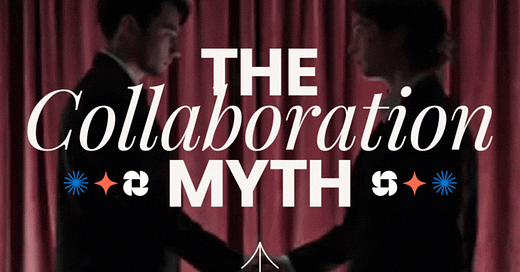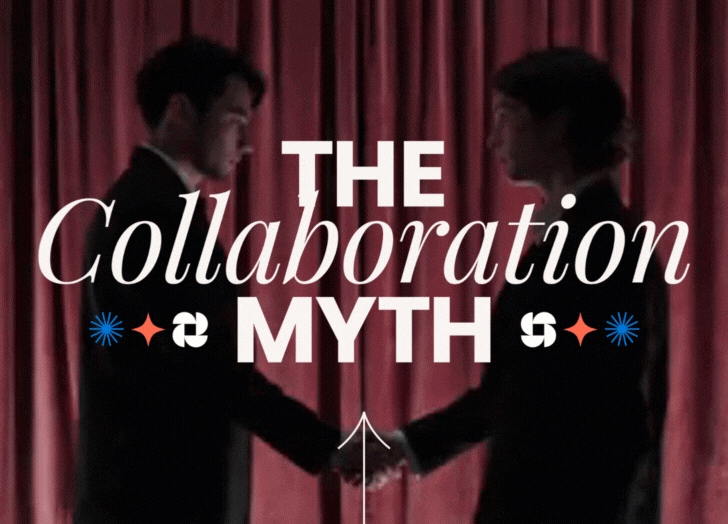It was supposed to be a creative free-for-all.
A big pitch for a global beverage client.
A boardroom covered in hundreds of sketches and references with every designer encouraged to push it, to imagine what was possible.
It looked collaborative.
It felt anything but.
The Creative Director walked in, and silence fell like a curtain.
Nobody wanted to speak first.
Everyone knew how harsh the feedback could be, and nobody wanted to share the first idea to get shot down.
I remember my stomach knotting. I didn’t speak. Neither did anyone else.
After a few minutes people chimed in here and there, not to lift the work, but to be seen adding something. It was rigid. Performative.
The Creative Director left without saying much, and the room emptied with the heavy energy of missed opportunity.
We talked about collaboration.
We set the stage for it.
But in that moment, it was clear: we hadn’t built the trust needed to actually do it.
The Myth We Tell Ourselves
Everyone loves the idea of collaboration.
It sounds good.
It looks good on a creds deck.
But real collaboration, the kind that actually builds ideas bigger than any one person, isn’t easy, and it isn’t common.
Most teams aren’t collaborating.
They’re competing politely.
They’re performing teamwork because it makes the team (and the leadership) look good.
But beneath the surface, it’s often about protecting egos, winning influence, or just getting through the meeting without risking anything.
Psychologists call it social loafing, when individuals in a group put in less effort, believing someone else will pick up the slack. That’s compounded by the bystander effect, where the presence of others diffuses personal responsibility. Then add in Groupthink, the pressure to conform - the quiet agreement that kills original thinking, and you have the perfect recipe for something that looks like collaboration, and is anything but.
“When the desire for harmony overrides the desire for realistic appraisal, poor decisions follow.” – Irving Janis
These psychological and organisational dynamics quietly sabotage collaboration. But because they’re subtle, we rarely call them out.
How Industry Culture Fuels Performative Collaboration
Part of the problem isn’t just how we collaborate day-to-day.
It’s how the creative industry talks about itself.
My personal bugbear is recruitment ads looking for “superstar creatives” — there’s a deeply ingrained hero narrative there.
We worship the solo visionary. The person with “the big idea.”
But that language has consequences.
It subtly trains us to compete instead of collaborate.
To chase credit instead of co-create.
To posture instead of partner.
And that’s not just an opinion.
Recent leadership research has shown that cultures focused on individual achievement are more likely to see collaboration as performative, rather than a strategic asset.
They reward visibility over contribution. And creatives, who already work in emotionally vulnerable, subjective spaces, start to armor up.
The Collaboration Spectrum — In Practice
Think of collaboration not as a switch, but a spectrum.
Most teams aren’t doing it well or badly, they’re just stuck somewhere in the middle.
This model helps make that visible:
🔴 Performative Collaboration
It looks like collaboration. But it’s all theatre.
A big pitch. A big room. Big pressure.
No one speaks.
People throw out half-baked ideas to be seen, not heard.
And the best ideas never make it to the table.
What’s really happening?
Psychological safety is low.
Fear overrides contribution.
People self-protect instead of sharing generously.
Outcome: Little to no progress. Creativity is stifled.
🟡 Transactional Collaboration
“You do your bit, I’ll do mine.”
Teams coordinate well. They deliver. But that’s where it ends.
Each role operates in parallel, with clear handoffs but little synergy.
What’s really happening?
Functional trust exists, but curiosity is low.
People default to process over partnership.
Feedback is rare and safe.
Outcome: Output is solid, but predictable. Innovation stalls.
🟢 True Partnership
You feel it before you can name it.
Conversations are sparky. Ideas evolve in real-time. No one owns the spotlight, but everyone owns the outcome.
You leave feeling proud of what you made together.
What’s really happening?
High psychological safety.
Shared purpose and accountability.
Ego is quiet. Craft is loud.
Outcome: Exceptional work. Deep pride. Repeatable creative momentum.
Deeper Insight: What Psychology, Neuroscience & Strategy Say
Psychological Safety (Amy Edmondson, Google Project Aristotle)
Teams with high psychological safety outperform others. People feel safe to take risks, speak up, and share ideas, even if they’re not fully formed. Without it, collaboration remains surface-level. Google found that psychological safety was the single most important factor in high-performing teams. It’s not about who is in the team, but how the team works together. They created internal protocols, like kicking off meetings with inclusive prompts, celebrating risk-taking, and encouraging feedback loops, to turn safety into a repeatable structure.
Pixar’s Braintrust – Radical Candor in Action
Pixar’s Braintrust sessions are a masterclass in creative partnership. A small group of trusted peers meet to critique works-in-progress. No one holds back, but all critique is given in service of the story, not ego. There’s no hierarchy in the room. Directors aren’t told what to do, they’re shown possibilities. The trust is so high that admitting “the story isn’t working” is seen as a strength, not a failure. It’s a ritualised form of collaboration where candour, care, and shared purpose drive every interaction. It works because the group knows: the goal isn’t to be right, it’s to get it right.
Ego Dynamics (Jaime Yáñez, Trayton Vance)
Unchecked ego kills collaboration. The moment individuals believe their value comes from being “right”, they stop listening. Leaders must model humility, not just confidence.
What Helps Move Teams Toward True Partnership
Here’s what the most collaborative teams do differently:
Model vulnerability: Leaders who admit what they don’t know create space for others to contribute without fear.
Design for candour: Processes (like Pixar’s Braintrust or Google’s psychological safety protocols) are intentionally built to invite critique and creativity.
Align around purpose, not personality: Strong collaborative teams have a unifying “why.” They care more about impact than credit.
Celebrate collective effort: When the team wins, everyone wins. True partners lift others up publicly, and often.
Zoom out, often: Partnership requires seeing beyond your task. Make time to re-sync on the bigger picture.
“It’s incredible what you can achieve if you don’t care who gets the credit.” — Harry Truman
Final Thought
The best creative work doesn’t shout. It listens. It trusts. And it’s built together.
Because at its best, collaboration isn’t just a process, it’s a way of showing up for each other.
It’s not the easy option. It’s the brave one.
I hope you enjoyed this and found it useful! Let’s keep the conversation going.
I’m sharing more real-world insights on creative leadership, brand identity, and building a career in design (the lessons I wish I’d known earlier). No fluff, just practical takeaways from experience.
🔔 Subscribe here to get the latest posts straight to your inbox






